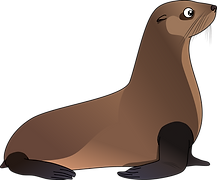
Meet our animals
Meet Dana, George, Nellie, Tuyakula, Freddie and Unduno, the animals that play the main roles in the educational material of the YourTernProject. They appear in a comic, class room activities and various games to learn kids and young adolescents about ecology, nature conservation and doing scientific research.
Dana - Damara Tern - Sternula balaenarum

The Damara Tern is one of the smallest tern species (23 cm in length) in the world. It breeds on the coasts of Southern Africa (Angola, Namibia, South Africa). 98% of the global population breeds in Namibia. The Damara Tern breeds on gravel plains in arid deserts between dunes. Nests are scraped in the sand and gravel and they lay one egg. Parents provide food for the chick by bringing single fish to the chick. It prefers sheltered bays, estuaries, lagoons and reefs to forage. Its conservations status is classified as 'Vulnerable' and the main threats to Damara Terns are human activities such as coastal development and recreational activity.
Dana means 'Leader of the Group' in the Damara language.
George - Namib Sand Gecko - Pachydactylus rangei
The Namib sand gecko is a small lizard (13 cm) that lives in the arid deserts of Angola, Namibia and South Africa. It has very large dark-coloured eyes allowing him to hunt at night. Its feet have fully webbed toes, enabling this gecko to dig a day-time burrow. Sand dunes and rocky plains in between dunes are prime habitat where it hunts crickets, grasshoppers and smaller insects. Their main source of liquid are dew droplets on vegetation. The main threats to the geckos are human activities that destroy their habitat. They are also hunted for food and to trade in the pet industry.

Nellie - Namaqua Chameleon - Chamaeleo namaquensis

Nellie is a Namaqua Chameleon, one of the largest (25 cm) chameleons in Africa. They live in the desert regions of southern Angola, Namibia and South Africa. The species is usually grey or brown coloured with some lighter patches. This allows thermoregulation when the dark parts absorb heat more efficiently in the morning. These dark parts get lighter during the day to reflect light during the heat. Namaqua Chameleons catch crickets, beetles and other insects with the very long sticky tongue which is twice its body length. They obtain most of their water through drinking dew and licking fog from surfaces. Uniquely they can also take up moisture through their skin through capillary action.
Tuyakula - Tractrac Chat - Emarginata tractrac
Tuyakula the Tractrac Chat is a small bird (15 cm) from the flycatcher familiy that breeds from southern Angola and western Namibia to western South Africa. It breeds in dunes, gravel plains and in desert scrub. The Namib form of the Tractrac Chat is pale-coloured. Remarkable for small passerines, they mate for life and pairs inhabit a territory throughout the year. They nest on the ground and lay two or three red eggs in a small scraped nest lined with straws under a shrub. Insects such as beetles, butterflies and locusts are their main source of food.
Tuyakula means 'Please assist us' in Oshiwambo language.

Freddie - Cape Fur Seal - Arctocephalus pusillus

Freddie is a Cape Fur Seal, a species that lives in very large colonies along the coasts of Southern Africa. It is the largest species of fur seal in the world (up to 2.3 m in length and 300 kg in weight). Their front flippers are used to move around underwater and are strong enough for acrobatic jumps and leaps out of the water. With there strong hind flippers they can move very quickly over land. Cape Fur Seals hunt for fish and squid at sea, and haul out and breed on rocky islands and beaches. At sea their main predator includes Great White Sharks and Killer Whales. On land, Black-backed Jackals and Brown Hyenas predate on Cape Fur Seals, in particular on young animals.
Onduno - Gemsbok - Oryx gazella
Onduno is a South African Oryx or Gemsbok, a large antelope species that lives in the Namibian deserts. The Gemsbok is depicted on the coat of arms of Namibia. They stand about 1.2 m tall at the shoulder and can be 2.4 m in length. Male Gemsboks can weigh up to 240 kg. Their spectacular horns are up to 85 cm in length. A herd of Gemsbok consists of about 10 - 40 animals. They live in deserts and live from either grazing grass or browsing from bushes and shrubs. They do not depend on drinking water but can take all of their fluids from food such as grass, roots, tubers and wild tsama melons and cucumbers.
Onduno means 'Oryx' in the Otjiherero langauage.

